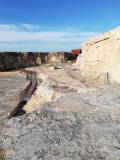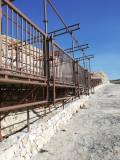URGENT INTERVENTIONS FOR THE PROTECTION AND CONSERVATION OF DINOSAUR FOOTPRINTS AND PALEOSURFACE AT THE PONTRELLI QUARRY IN ALTAMURA The Pontrelli Quarry is located in Puglia, in the area of Altamura; here, in 1999, about four thousand dinosaur footprints were discovered. The interventions carried out by Cobar on the quarry were especially aimed at preserving and […]
[...]Read MoreURGENT INTERVENTIONS FOR THE PROTECTION AND CONSERVATION OF DINOSAUR FOOTPRINTS AND PALEOSURFACE AT THE PONTRELLI QUARRY IN ALTAMURA
The Pontrelli Quarry is located in Puglia, in the area of Altamura; here, in 1999, about four thousand dinosaur footprints were discovered. The interventions carried out by Cobar on the quarry were especially aimed at preserving and protecting the precious footprints: this site holds exceptional importance, since it contains the most dinosaur footprints in a single site in Europe. The importance of this finding lies in the extremely high biodiversity of the dinosaurs that, during the Late Cretaceous era, walked this land and left their footprints: over two hundred animals, belonging to at least five different families of dinosaurs, both herbivores and carnivores.
The footprints’ size vary from 5-6 cm up to 40-45 cm, suggesting the presence of animals taller than 10 meters. Many footprints also show the folds in dinosaur skin. Ever since these footprints have been brought to light, they have remained exposed to atmospheric agents and to human tampering.
In order to perform studies on this site and put in place all necessary protection measures, a series of exams has been carried out to gather expertise over the site and provide more information, that would also prove useful for future studies. A series of interventions have been carried out, devised by specialists in the field of geology and palaeontology: the goal of these interventions is to preserve the footprints over time in the best possible way, along with the limestone terrain they were left in; following a thorough scientific enquiry, the second goal is to fully showcase and share this incredible site as part of the broader cultural and landscape heritage in Puglia.
Paleontological, geological, stratigraphical, conservation and communication studies have been carried out; moreover, excavation works have been performed, as well as the creation of landslide barriers and paving for the creation of paths that allow completely safe access to the quarry.
The most important intervention focuses the wall located at the beginning of the footbridge, which was built to ensure the passage of visitors. On this section of rock, operations were carried out to remove some of the blocks, soil nailing and the creation of a landslide barrier at the base of the wall itself (starting point of the planned footbridge).
The Pontrelli quarry is a “gravel pit” type quarry, whic means it is subjected to internal and external water flows that can determine erosion processes over time, even on stone surfaces such as the one in question.
On the basis of the conducted hydrological study, the containment intervention is centred around the construction of a channel network to intercept water flow, extending for a total length of 412 meters, and consisting of mostly stone walls and mortar attached to the rock walls and leading to the final exhaust channel.
As previously mentioned, geological and paleontological studies, along with morphological analyses, were carried out. The elaboration of the data obtained from the paleontological survey and the analyses carried out on the rock samples, the detection and classification of footprints and tracks by vertebrates, produced an elaborate document that includes drawings, tables, graphs and statistical analysis of numerical data, which prove useful for the representation of the study carried out. The elaboration of the data was completed by the creation of a database that would display, in a clear and simple way, all the data useful for spreading and sharing this study.
Finally, the interventions carried out inside the quarry focus on the creation of a paving-type lawn driveway in plastic honeycomb material, from the current entrance to the quarry up to its floor; the installation of a connecting ramp between the previous paving and the horizontal levels of the quarry fronts allows the public to observe the operations in progress; the supply and installation of information signs of the activities in progress – during the execution of the work – show the final results. These interventions were carried out to improve and facilitate access to the quarry for the public.
Read Less











































